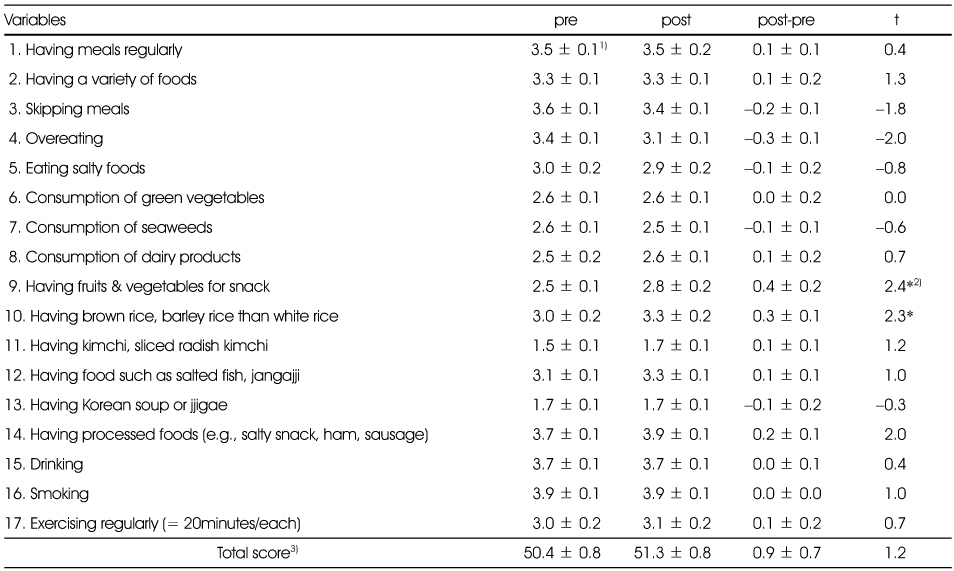References
1. Alderman MH, Cohen H, Madhavan S. Diabetes and cardiovascular events in hypertensive patients. Hypertension 1999. 33(5)1130–1134.
2. Baek SH, Cho HJ. The management of hypertension by internists and family physicians in general hospital. J Korean Acad Fam Med 1997. 18(8)793–801.
3. Cho KO, Kwon SH. A comparative study on food habits and nutrient intakes with body mass index of hypertensive patients commuting to a local health center. J Korean Diet Assoc 2002. 8(2)185–198.
4. Choi YJ, Park YS, Kim C, Chang YK. Evaluation of functional ability and nutritional risk according to self-rated health (SRH) of the elderly in Seoul and Kyunggi-do. Korean J Nutr 2004. 37(3)223–235.
5. Eum SO, Kim SD, Lee JS. Effects of hypertension education programs on knowledge, attitude and practice in hypertension patients. Korean Public Health Res 2007. 33(2)162–174.
6. Green LW, Kreuter MW. Health program planning - An educaitonal and ecological approach 2005. New York: McGraw Hill;
7. Kang EJ, Kim NY, Seok JY. An estimation of health-adjusted life expectancy (HALE) for Koreans. Korean J Health Policy Adm 2008. 18(1)108–126.
8. Kang HJ, Shin EM, Kim KW. Evaluation of nutrition education for diabetes mellitus management of older adults. Korean J Community Nutr 2009. 14(6)734–745.
9. Kim GN, Lee KS. Nutrition knowledge, dietary attitudes, and food behaviors of college students. Korean J Community Nutr 1996. 1(1)89–99.
10. Kim GN, Lee JW, Park YS, Hyun TS. Nutritional status of the elderly living in Cheongju - I. Health-related habits, dietary behaviors and nutrient intakes -. Korean J Community Nutr 1997. 2(4)556–567.
11. Kim KR, Hong SA, Kim MK. Nutritional status and food insufficiency of Korean population through the life-course by education level based on 2005 National Health and Nutrition Survey. Korean J Nutr 2008. 41(7)667–681.
12. Kim KW. Issues and directions in developing nutrition education for older adults in Korea. Korean J Community Nutr 2000. 2(1)71–84.
13. Kim KW, Kang HJ, Shin EM, Kim HS. Development of the booklet "prevention and management of hypertension for older adults". Korean J Community Nutr 2004. 6(1)26–34.
14. Kim TY, Eom SH. Older adults with type 2 diabetes improve glycemic control after nutritional education program at the public health center. J Korean Diet Assoc 2004. 10(2)205–217.
15. Kim YM, Choi HR, Park DY, Lim JB, Won CW, Kim BS, Park YW. The comparison of the quality of life between the well-controlled hypertension group and the uncontrolled hypertension group. J Korean Acad Fam Med 2001. 22(4)565–574.
16. Korean Dietetic Association. Eye measurement of food using pictures 1999. Seoul: Korean Dietetic Association;
18. Korean Nutrition Society. Dietary reference intakes for Koreans 2005. Seoul: Korean Nutrition Society;
19. Kolasa KM. Summary of the JNC 7 guidelines for the prevention and treatment of high blood pressure. J Nutr Educ Behav 2003. 35(5)226–227.
20. Kwak EH, Lee SL, Lee HS, Kwun IS. Relation dietary and urinary Na, K, and Ca level to blood pressure in elderly people in rural area. Korean J Nutr 2003. 36(1)75–82.
21. Lee HJ. Effect of individual health education the medical clinic of public health centers on knowledge, self-efficacy, and self-care behavior in clients with hypertension. J Korea Community Health Nurs Acad Soc 2004. 18(1)80–89.
22. Lee YS, Kim HK. Nutritional status and cognitive status of the elderly using public health center in Ulsan. Korean J Nutr 2002. 35(10)1070–1080.
23. Ministry for Health, Welfare and Family Affairs & Korea Centers for Disease Control and Prevention. 2007 National Health Statistics - The 4th Korea National Health and Nutrition Examination Survey. the first year(2007) 2008. Korea: Korea Centers for Disease Control and Prevention;
24. Ministry of Health and Welfare, Korea Institute for Health and Social Welfares. The Third Korea National Health and Nutrition Examination Survey (KNHANES III), 2005 2006. Seoul:
25. Moon HK, Joung HJ. Dietary risk factors of hypertension in the elderly. Korean J Nutr 1999. 32(1)90–100.
26. Morrison AC, Bray MS, Folsom AR, Boerwinkle E. ADD1 460W Allele associated with cardiovascular disease in hypertensive individuals. Hypertension 2002. 39(6)1053–1057.
27. Park NH. The effect of self-help programs for hypertensives in community areas. J Korean Soc Health Educ Promot 2003. 20(3)207–219.
28. Rajgopal R, Cox RH, Lambur M, Lewis EC. Cost-benefit indicates the positive economic benefits of the expanded food and nutrition education program related to chronic disease prevention. J Nutr Educ Behav 2002. 34(1)26–37.
29. Sahyoun NR. Nutrition education for the healthy elderly population: Isn's it time? J Nutr Educ Behav 2002. 34Suppl 1. S42–S47.
30. Sesso HD, Chen RS, L'Italien GJ, Lapuerta P, Lee WC, Glynn RJ. Blood pressure lowering and life expectancy based on a Markov model of cardiovascular events. Hypertension 2003. 42(5)885–890.
31. Son SM, Kim MJ. The effect of nutrition education program for various chronic disease in elderly visiting public health center. Korean J Community Nutr 2001. 6(4)668–677.
32. Yim KS. Analysis of the characteristics of an attendee in an elderly nutrition education program - Using the factors of health promotion model -. Korean J Community Nutr 1998. 3(4)609–621.
33. Yim KS. Strategies to improve elderly nutrition : Comparisons of dietary behavior according to the mean nutrient adequacy ratio. Korean J Community Nutr 1999. 4(1)46–56.
34. Yim KS, Min YH, Lee HY, Kim YJ. Strategies to improve elderly nutrition through nutrition education : Evaluation of the effectiveness of the program. Korean J Community Nutr 1999. 4(2)207–218.
35. Yim KS. Evaluation of the effectiveness of a nutrition education program for hypertensive patients at the community level. Korean J Community Nutr 2000. 5(4)654–661.
36. Yim KS, Han MH, Kang YH, Park HR, Kim CH. Analysis of dietary characteristics of participants attending the nutrition education program for hypertensive patients at a public health center. J Korean Diet Assoc 2000. 6(2)125–135.
37. Yim KS. The effects of a nutrition education program for hypertensive female elderly at the public health center. Korean J Community Nutr 2008. 13(5)640–652.
38. Yoon JS, Jeong YH, Park JA, Oh HM. The effect of individualized nutritional education on adults having two or more symptoms of chronic degenerative disease. Korean J Community Nutr 2002. 7(6)794–802.






